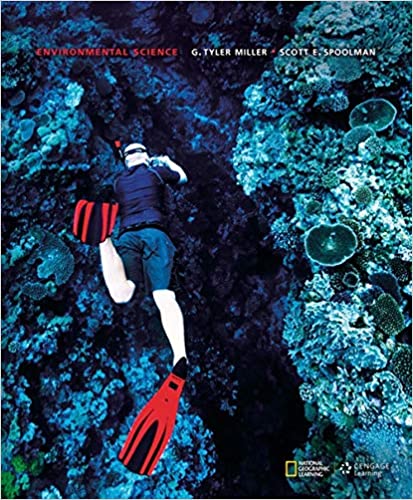
Environmental Science 15th Edition by Scott Spoolman,Tyler Miller
Edition 15ISBN: 978-1305090446
Environmental Science 15th Edition by Scott Spoolman,Tyler Miller
Edition 15ISBN: 978-1305090446 Exercise 2
GEOLOGICAL PROCESSES AFFECT BIODIVERSITY
The earth's surface has changed dramatically over its long history. Scientists have discovered that huge flows of molten rock within the earth's interior have broken its surface into a number of gigantic solid plates, called tectonic plates. For hundreds of millions of years, these plates have drifted slowly on the planet's mantle (Figure 4.D).
Rock and fossil evidence indicates that 200-250 million years ago, all of the earth's present-day continents were connected in a supercontinent called Pangaea (Figure 4.D, left). About 135 million years ago, Pangaea began splitting apart as the earth's tectonic plates moved, eventually resulting in the present-day locations of the continents (Figure 4.D, right).
The fact that tectonic plates drift has had two important effects on the evolution and distribution of life on the earth. First, the locations of continents and oceanic basins have greatly influenced the earth's climate and thus have helped to determine where plants and animals can live. Second, the breakup, movement, and joining of continents has allowed species to move, adapt to new environments, and form new species through speciation.
Adjoining tectonic plates that are grinding along slowly next to one another sometimes shift quickly. Such sudden movement of tectonic plates can cause earthquakes, which can also affect biological evolution by causing fissures in the earth's crust that, on rare occasions, can separate and isolate populations of species. Over long periods, this can lead to the formation of new species as each isolated population changes genetically in response to new environmental conditions. Volcanic eruptions that occur along the boundaries of tectonic plates can also affect extinction and speciation by destroying habitats and reducing, isolating, or wiping out populations of species. We discuss these processes in greater detail in Chapter 12.
Critical Thinking
The earth's tectonic plates, including the one you are riding on, typically move at about the rate at which your fingernails grow. If they stopped moving, how might this affect the future biodiversity of the planet?

FIGURE 4.D Over millions of years, the earth's continents have moved very slowly on several gigantic tectonic plates. Question: How might an area of land splitting apart cause the extinction of a species?
The earth's surface has changed dramatically over its long history. Scientists have discovered that huge flows of molten rock within the earth's interior have broken its surface into a number of gigantic solid plates, called tectonic plates. For hundreds of millions of years, these plates have drifted slowly on the planet's mantle (Figure 4.D).
Rock and fossil evidence indicates that 200-250 million years ago, all of the earth's present-day continents were connected in a supercontinent called Pangaea (Figure 4.D, left). About 135 million years ago, Pangaea began splitting apart as the earth's tectonic plates moved, eventually resulting in the present-day locations of the continents (Figure 4.D, right).
The fact that tectonic plates drift has had two important effects on the evolution and distribution of life on the earth. First, the locations of continents and oceanic basins have greatly influenced the earth's climate and thus have helped to determine where plants and animals can live. Second, the breakup, movement, and joining of continents has allowed species to move, adapt to new environments, and form new species through speciation.
Adjoining tectonic plates that are grinding along slowly next to one another sometimes shift quickly. Such sudden movement of tectonic plates can cause earthquakes, which can also affect biological evolution by causing fissures in the earth's crust that, on rare occasions, can separate and isolate populations of species. Over long periods, this can lead to the formation of new species as each isolated population changes genetically in response to new environmental conditions. Volcanic eruptions that occur along the boundaries of tectonic plates can also affect extinction and speciation by destroying habitats and reducing, isolating, or wiping out populations of species. We discuss these processes in greater detail in Chapter 12.
Critical Thinking
The earth's tectonic plates, including the one you are riding on, typically move at about the rate at which your fingernails grow. If they stopped moving, how might this affect the future biodiversity of the planet?

FIGURE 4.D Over millions of years, the earth's continents have moved very slowly on several gigantic tectonic plates. Question: How might an area of land splitting apart cause the extinction of a species?
Explanation
The earth's surface has changed drastica...
Environmental Science 15th Edition by Scott Spoolman,Tyler Miller
Why don’t you like this exercise?
Other Minimum 8 character and maximum 255 character
Character 255


